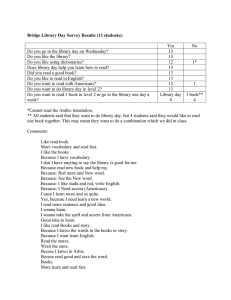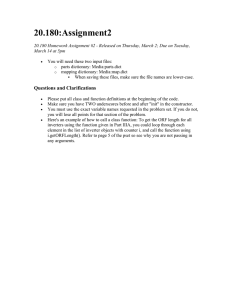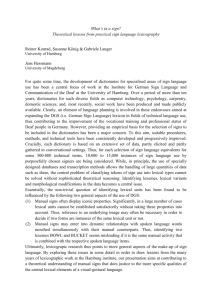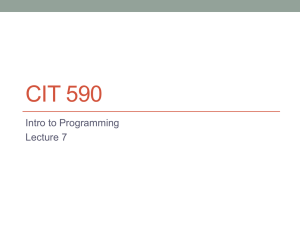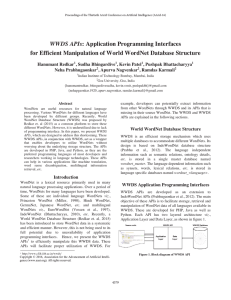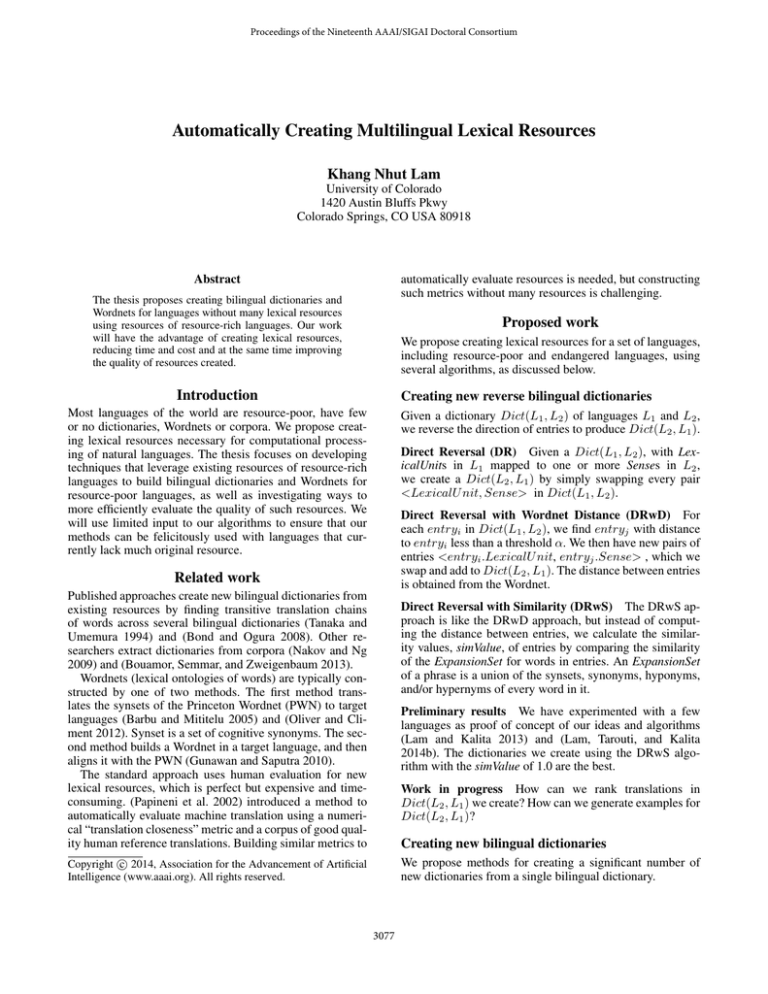
Proceedings of the Nineteenth AAAI/SIGAI Doctoral Consortium
Automatically Creating Multilingual Lexical Resources
Khang Nhut Lam
University of Colorado
1420 Austin Bluffs Pkwy
Colorado Springs, CO USA 80918
Abstract
automatically evaluate resources is needed, but constructing
such metrics without many resources is challenging.
The thesis proposes creating bilingual dictionaries and
Wordnets for languages without many lexical resources
using resources of resource-rich languages. Our work
will have the advantage of creating lexical resources,
reducing time and cost and at the same time improving
the quality of resources created.
Proposed work
We propose creating lexical resources for a set of languages,
including resource-poor and endangered languages, using
several algorithms, as discussed below.
Introduction
Creating new reverse bilingual dictionaries
Most languages of the world are resource-poor, have few
or no dictionaries, Wordnets or corpora. We propose creating lexical resources necessary for computational processing of natural languages. The thesis focuses on developing
techniques that leverage existing resources of resource-rich
languages to build bilingual dictionaries and Wordnets for
resource-poor languages, as well as investigating ways to
more efficiently evaluate the quality of such resources. We
will use limited input to our algorithms to ensure that our
methods can be felicitously used with languages that currently lack much original resource.
Given a dictionary Dict(L1 , L2 ) of languages L1 and L2 ,
we reverse the direction of entries to produce Dict(L2 , L1 ).
Direct Reversal (DR) Given a Dict(L1 , L2 ), with LexicalUnits in L1 mapped to one or more Senses in L2 ,
we create a Dict(L2 , L1 ) by simply swapping every pair
<LexicalU nit, Sense> in Dict(L1 , L2 ).
Direct Reversal with Wordnet Distance (DRwD) For
each entryi in Dict(L1 , L2 ), we find entryj with distance
to entryi less than a threshold α. We then have new pairs of
entries <entryi .LexicalU nit, entryj .Sense> , which we
swap and add to Dict(L2 , L1 ). The distance between entries
is obtained from the Wordnet.
Related work
Published approaches create new bilingual dictionaries from
existing resources by finding transitive translation chains
of words across several bilingual dictionaries (Tanaka and
Umemura 1994) and (Bond and Ogura 2008). Other researchers extract dictionaries from corpora (Nakov and Ng
2009) and (Bouamor, Semmar, and Zweigenbaum 2013).
Wordnets (lexical ontologies of words) are typically constructed by one of two methods. The first method translates the synsets of the Princeton Wordnet (PWN) to target
languages (Barbu and Mititelu 2005) and (Oliver and Climent 2012). Synset is a set of cognitive synonyms. The second method builds a Wordnet in a target language, and then
aligns it with the PWN (Gunawan and Saputra 2010).
The standard approach uses human evaluation for new
lexical resources, which is perfect but expensive and timeconsuming. (Papineni et al. 2002) introduced a method to
automatically evaluate machine translation using a numerical “translation closeness” metric and a corpus of good quality human reference translations. Building similar metrics to
Direct Reversal with Similarity (DRwS) The DRwS approach is like the DRwD approach, but instead of computing the distance between entries, we calculate the similarity values, simValue, of entries by comparing the similarity
of the ExpansionSet for words in entries. An ExpansionSet
of a phrase is a union of the synsets, synonyms, hyponyms,
and/or hypernyms of every word in it.
Preliminary results We have experimented with a few
languages as proof of concept of our ideas and algorithms
(Lam and Kalita 2013) and (Lam, Tarouti, and Kalita
2014b). The dictionaries we create using the DRwS algorithm with the simValue of 1.0 are the best.
Work in progress How can we rank translations in
Dict(L2 , L1 ) we create? How can we generate examples for
Dict(L2 , L1 )?
Creating new bilingual dictionaries
We propose methods for creating a significant number of
new dictionaries from a single bilingual dictionary.
c 2014, Association for the Advancement of Artificial
Copyright Intelligence (www.aaai.org). All rights reserved.
3077
Automatically evaluating dictionaries
Direct approach Given a Dict(S,English) with entries
(si , ek ) and a target language D, we create a Dict(S,D) having entries (si , dj ) where si and dj are associated with ek
via a free machine translator, Microsoft Translator1 (MT).
We will upload resources we create on a Website and solicit
feedback from the appropriate language communities. We
will also collect bilingual or monolingual lexical resources
for these languages. From the collected feedback, human
evaluation and collected data, we will develop algorithms
for automatically evaluating resources we create.
Using publicly available Wordnets Given an entry
(si , rj ) from Dict(S,R) where R has a Wordnet linked to
PWN, we find Offset-POSs, each referring to a synset with a
particular POS in the R Wordnet to which rj belongs. Then,
we extract words in each Offset-POS from Wordnets in several languages linked to PWN. Next, we translate extracted
words to D using MT, to generate candidates. The correct
translations are chosen by disambiguating candidates.
Work in progress There is little chance of getting feedback for resources among resource-poor languages. How
can we apply the rules we discover for evaluating resources
of resource-rich languages to resources of resource-poor languages? How much feedback is enough to infer suitable
rules for evaluating resources?
Preliminary results The dictionaries we created using
4 Wordnets are better than those we created using other
approaches. We have created 48 new bilingual dictionaries, out of which 30 pairs of languages are not supported
by MT, from 5 existing dictionaries. We have also experimented with endangered languages to evaluate our work
(Lam, Tarouti, and Kalita 2014b).
Conclusion
To be able to automatically create plentiful lexical resources
for resource-poor and endangered languages, we need processes that do not require many resources to begin with,
which presents challenging problems for the computational
scientist. Our research will attempt to make progress on
these problems, by bootstrapping and leveraging resources
available for resource-rich languages. Out current goal is
to create 5 new core Wordnets and 516 new dictionaries to
demonstrate the effectiveness of our approaches.
Work in progress We want to add about 12 languages not
covered by MT and 6 of them to be endangered. How many
Wordnets should be used to create the best dictionaries?
Constructing Wordnets
References
Barbu, E., and Mititelu, V. B. 2005. Automatic building of
Wordnets. RANLP.
Bond, F., and Ogura, K. 2008. Combining linguistic resources to create a machine-tractable Japanese-Malay dictionary. Language Resources & Evaluation 42(2):127–136.
Bouamor, D.; Semmar, N.; and Zweigenbaum, P. 2013. Using Wordnet and semantic similarity for bilingual terminology mining from comparable corpora. ACL 16–23.
Gunawan, G., and Saputra, A. 2010. Building synsets for Indonesian Wordnet with monolingual lexical resources. IALP
297–300.
Lam, K. N., and Kalita, J. 2013. Creating reverse bilingual
dictionaries. In NAACL-HLT, 524–528.
Lam, K. N.; Tarouti, F. A.; and Kalita, J. 2014a. Automatically constructing Wordnet synsets. In ACL, accepted.
Lam, K. N.; Tarouti, F. A.; and Kalita, J. 2014b. Creating
lexical resources for endangered languages. In ComputEL
at ACL, accepted.
Nakov, P., and Ng, H. T. 2009. Improved statistical machine translation for resource-poor languages using related
resource-rich languages. In EMNLP, volume 3, 1358–1367.
Oliver, A., and Climent, S. 2012. Parallel corpora for Wordnet construction: machine translation vs. automatic sense
tagging. CICLing 110–121.
Papineni, K.; Roukos, S.; Ward, T.; and Zhu, W.-J. 2002.
Bleu: a method for automatic evaluation of machine translation. ACL 311–318.
Tanaka, K., and Umemura, K. 1994. Construction of a bilingual dictionary intermediated by a third language. COLING
1:297–303.
This section proposes approaches to automatically build
Wordnets for languages with limited resources. We extract words belonging to each Offset-POS from intermediate
Wordnets and translate them to the target language D using 3 approaches below. Then, we apply a ranking method
on candidates to find the correct translations for a specific
Offset-POS in the target language.
Direct approach This method translates words in each
Offset-POS in the PWN to D using a Dict(English,D).
Using Intermediate Wordnets (IW) For each OffsetPOS, we extract its corresponding synsets from intermediate
Wordnets and translate them to D using dictionaries.
Using Intermediate Wordnets and a single bilingual dictionary This approach is similar to IW approach, but instead of translating immediately from the intermediate languages to D, we translate synsets extracted from intermediate Wordnets to English, then translate them to D.
Preliminary results We have created Wordnet synsets
for a few languages as reported in (Lam, Tarouti, and
Kalita 2014a). The average coverage percentage of Wordnet
synsets we create is 44.85%.
Work in progress We are constructing full Wordnets for
several languages which do not have many resources. How
can we maintain the complex agglutinative morphology, culture specific meanings and usages of words and phrases of
target languages in the Wordnets we create?
1
https://datamarket.azure.com/dataset/bing/microsofttranslator
3078



